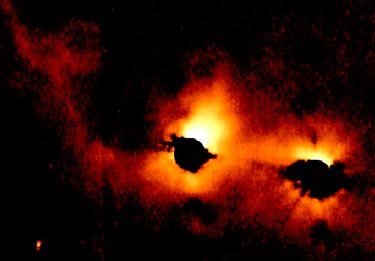
Telescopes now routinely yield detailed images of the cosmos, and in the process help unravel some of the mysteries surrounding our own existence. But one big unanswered question is how the Earth and our planetary neighbours were created from the primordial dust surrounding the young Sun.
In the past two decades we have come to understand that stars form “protoplanetary disks” with radii that can reach up to several hundred times the mean distance between the Sun and the Earth. Astrophysicists have studied the structure of such disks at several radiation wavelengths, which has led to a growing understanding of the star-formation process.
However, most stars form in pairs (and sometimes more complex groups) and numerical models produce conflicting results because of the complex dynamical interaction of two cosmological bodies. Our understanding has also been held back by a lack of direct observations of such systems.
This image reveals a rare glimpse of a young multiple protoplanetary disk encircling a two-star system located 160 ps away in the Ophiuchus constellation around the celestial equator. Having pinpointed the binary system, the researchers led by Satoshi Mayama of the Graduate University for Advanced Studies, Japan, placed a coronograph over the Subaru Telescope in Hawaii. This enabled them to filter out the direct light from the twin stars and reveal two individual protoplanetary disks bridged by a complex interaction.
Comparison with numerical models suggests that there could be a channelling of debris from one disk to the other – a finding that the researchers say might reveal where planets can form in binary systems (Science 10.1126/science.1179679).
As the International Year of Astronomy (IYA2009) draws to a close, its organisers must be delighted at the huge attention given over the last 12 months to a field that has come so far since Galileo turned his primitive instrument to the Moon 400 years ago.



